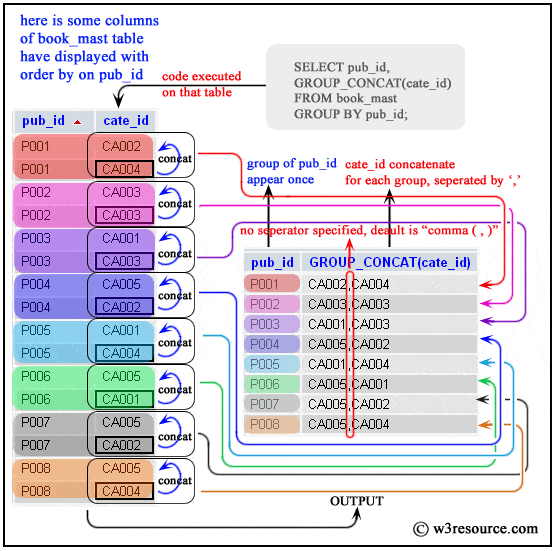SQLite group_concat() function
Description
The group_concat() function returns a string with concatenated non-NULL value from a group.
Syntax:
group_concat(X) group_concat(X, Y)
The group_concat() function returns a string which is the concatenation of all non-NULL values of X. If parameter Y is present then it is used as the separator between instances of X. A comma (",") is used as the separator if Y is omitted. The order of the concatenated elements is arbitrary.
Example: SQLite group_concat() function
The following SQLite statement will return a list of a comma(,) separated 'cate_id's for each group of 'pub_id' from the book_mast table.
Sample table: book_mast
Sample Output:
sqlite> SELECT pub_id,group_concat(cate_id) ...> FROM book_mast ...> GROUP BY pub_id; pub_id group_concat(cate_id) ---------- --------------------- P001 CA002,CA004 P002 CA003,CA003 P003 CA001,CA003 P004 CA002,CA005 P005 CA001,CA004 P006 CA001,CA005 P007 CA005,CA002 P008 CA004,CA005
Pictorial Presentation

Example: SQLite group_concat() with order by
The following SQLite statement will return unique “cate_id”s , as a list of strings separated by the commas, in ascending order for each group of 'pub_id' from the book_mast table. The order can be changed in descending, using 'DESC' instead of 'ASC' at the end of the select statement.
Sample table: book_mast
Sample Output:
sqlite> SELECT pub_id,group_concat(DISTINCT cate_id) ...> FROM book_mast ...> GROUP BY pub_id ...> ORDER BY group_concat(DISTINCT cate_id) ASC; pub_id group_concat(DISTINCT cate_id) ---------- ------------------------------ P003 CA001,CA003 P005 CA001,CA004 P006 CA001,CA005 P001 CA002,CA004 P004 CA002,CA005 P002 CA003 P008 CA004,CA005 P007 CA005,CA002
Example: SQLite group_concat() with distinct
The following SQLite statement will return the unique “cate_id”s, as a list of strings separated by the commas, for each group of 'pub_id' from the book_mast table.
Sample table: book_mast
Sample Output:
sqlite> SELECT pub_id,group_concat(DISTINCT cate_id) ...> FROM book_mast ...> GROUP BY pub_id; pub_id group_concat(DISTINCT cate_id) ---------- ------------------------------ P001 CA002,CA004 P002 CA003 P003 CA001,CA003 P004 CA002,CA005 P005 CA001,CA004 P006 CA001,CA005 P007 CA005,CA002 P008 CA004,CA005
